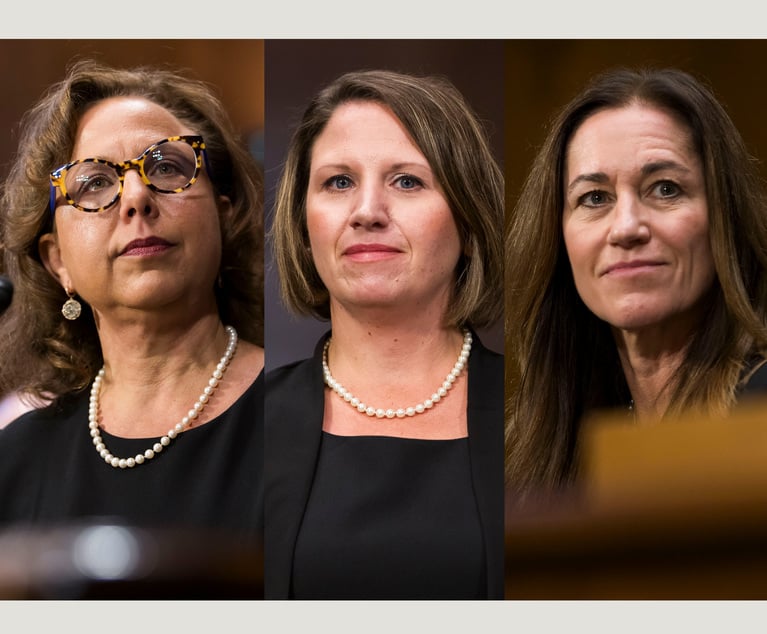Top Misinterpretations of Master Service Agreements by USCIS
Over the past several years, the agency charged with adjudicating immigration benefits requests, U.S. Citizenship & Immigration Services (USCIS), has gradually evolved its review process and has adopted a more searching inquiry of employment visa adjudications.
February 12, 2020 at 01:03 PM
6 minute read
 Maria M. Mihaylova of Klasko Immigration Law Partners.
Maria M. Mihaylova of Klasko Immigration Law Partners.
Traditionally, business immigration law has existed in relative isolation, with issues so narrowly and rigidly constrained that legal professionals focusing on other areas did not have cause to be aware of immigration-related issues. Times are changing, though, for employment lawyers and those specializing in procurement and services contracting.
Over the past several years, the agency charged with adjudicating immigration benefits requests, U.S. Citizenship & Immigration Services (USCIS), has gradually evolved its review process and has adopted a more searching inquiry of employment visa adjudications. Skyrocketing denial and request for evidence (RFE) rates have been widely reported and discussed, but the data does not help understand the reasoning of USCIS adjudicators for those trying to understand these numbers.
The current administration's "Buy American Hire American" (BAHA) executive order has placed an added burden on employers to justify their need for a foreign worker and has also placed an added adjudicatory burden on USCIS officers. In the past, USCIS would focus on establishing whether an offered position requires a bachelor's degree level of education or equivalent experience and whether the sponsored worker is qualified for a given job based on their education and experience. The evidence was often limited to the employer-provided job description, and the education credentials and experience documentation for the sponsored foreign national (depending on the specific visa category).
Today, this evidence is no longer sufficient. Employers are now expected to provide extensive documentation about their financials, client contracts, organization structure, size and business model. The adjudication process now includes a wide range of business concepts, including the business need for the role, evidence of sufficient work for each sponsored employee for the entire period of requested time, and the right of the sponsoring entity to control the work of the employee during that time.
As a result, immigration now increasingly begins to overlap with areas of law, most notably, contracts, particularly regarding H-1B visa petitions. More specifically, H-1B employers whose business models require placement of workers at end-client sites are increasingly fighting an uphill, and often losing, battle with USCIS when trying to confirm that, as the petitioning U.S. organization, they have the right to control their sponsored foreign nationals.
While the H-1B regulations always required that the petitioning employer demonstrate they are offering a bona fide job opportunity, up until 2010, employers only had to reasonably outline the terms of offered employment. They were not required to submit specific itineraries when their employees would work at multiple sites. Neither did employers have to specify whether the worksites are employer-owned, or whether they are end-client locations. While USCIS had the discretion to seek additional information, it only utilized it when misrepresentation was suspected.
In 2010 USCIS issued a new policy memo, which expressly instructed USCIS officers to confirm the bona fide employer-employee relationship in third-party placement cases under the common law right-to-control test. USCIS began to consistently issue Requests for Evidence, asking petitioning employers to produce copies of their end-client contracts to verify the nature of the working relationship established between the petitioner and their end-client, seeking to weed out potential job shops and staffing agencies.
Providing offer letters, employer manuals, end-client contracts, organizational charts and performance evaluations became the norm for consulting companies. However, with USCIS officers being asked to conduct what essentially is legal analysis, confusion and misinterpretation of contractual agreements followed soon after the introduction of the 2010 memo.
These misinterpretations frustrate both immigration attorneys trying to protect the right of their clients to hire qualified workers to meet their business needs, and corporate attorneys drafting the contractual agreements USCIS is supposed to review.
For example, contracts can appear outdated, often because a company has had a long-standing relationship with their client, and USCIS will challenge them as insufficient due to their dates of execution and based on the premise that USCIS cannot confirm the contract is still valid. This reveals that USCIS does not know how to properly interpret or does not want to give any consideration to term and termination clauses, which attorneys often include to proactively define the scope of an engagement. Some contracts that include a general scope of service statement are deemed insufficient because USCIS demands a more specific description of the work to be done. Provisions allowing the end-client to request and approve specific employees or review their end work product are also increasingly interpreted as providing the end-client with control of the worker (so that a petition by the vendor cannot be approved), rather than as an end-client's right to ensure the product or service is up to specifications.
While both business and immigration attorneys have tried to remain proactive about finding supplemental forms of evidence to help USCIS understand the terms of contracts, USCIS is continuing to effectively impede sponsoring employers' ability to smoothly deliver their contractual obligations. Although USCIS has been reviewing contracts for third-party placements for the past decade, the common misinterpretations above persist, leaving both immigration attorneys and corporate legal counsel struggling to find a way to educate adjudicators and to avoid costly litigation as a solution.
There are potential solutions petitioning employers can consider to help decrease the risk of denial, and in turn, benefit the end-clients who rely on their services. One such solution has been to re-evaluate whether the work in question must be done at the premises of the end-client. USCIS has long recognized that occasional visits to client sites to ensure the product or service delivered is functioning properly are appropriate, and do not trigger questions with respect to which party is the H-1B worker's direct employer. Another solution may be for petitioning employers to rent out office space and have a supervisor onsite, thus taking the case out of the third-party placement model. A third solution could be to revise existing contracts and bolster the scope of service sections to clarify the vendor's rights of control.
Different solutions will work better for various circumstances but addressing and strategizing such changes proactively is of substantial importance. After a decade of misinterpreting third-party consultant contracts, USCIS adjudicators are highly unlikely to start improving any time soon, so the onus remains on the petitioning employers, and their legal counsel, to work together to strategize a solution with their end clients that does not rely on a USCIS officer's ability to understand a key piece of petition evidence.
Maria M. Mihaylova is an associate at Klasko Immigration Law Partners and works closely with both corporate and individual clients on a wide range of business and family-based immigration matters. An immigrant herself, Maria is well-attuned to the needs of foreign nationals who are evaluating and planning out their immigration options in the United States.
This content has been archived. It is available through our partners, LexisNexis® and Bloomberg Law.
To view this content, please continue to their sites.
Not a Lexis Subscriber?
Subscribe Now
Not a Bloomberg Law Subscriber?
Subscribe Now
NOT FOR REPRINT
© 2025 ALM Global, LLC, All Rights Reserved. Request academic re-use from www.copyright.com. All other uses, submit a request to [email protected]. For more information visit Asset & Logo Licensing.
You Might Like
View All
Pa. Federal District Courts Reach Full Complement Following Latest Confirmation

The Defense Bar Is Feeling the Strain: Busy Med Mal Trial Schedules Might Be Phila.'s 'New Normal'
7 minute read
Federal Judge Allows Elderly Woman's Consumer Protection Suit to Proceed Against Citizens Bank
5 minute read
Judge Leaves Statute of Limitations Question in Injury Crash Suit for a Jury
4 minute readTrending Stories
- 1January Petitions Press High Court on Guns, Birth Certificate Sex Classifications
- 2'A Waste of Your Time': Practice Tips From Judges in the Oakland Federal Courthouse
- 3Judge Extends Tom Girardi's Time in Prison Medical Facility to Feb. 20
- 4Supreme Court Denies Trump's Request to Pause Pending Environmental Cases
- 5‘Blitzkrieg of Lawlessness’: Environmental Lawyers Decry EPA Spending Freeze
Who Got The Work
J. Brugh Lower of Gibbons has entered an appearance for industrial equipment supplier Devco Corporation in a pending trademark infringement lawsuit. The suit, accusing the defendant of selling knock-off Graco products, was filed Dec. 18 in New Jersey District Court by Rivkin Radler on behalf of Graco Inc. and Graco Minnesota. The case, assigned to U.S. District Judge Zahid N. Quraishi, is 3:24-cv-11294, Graco Inc. et al v. Devco Corporation.
Who Got The Work
Rebecca Maller-Stein and Kent A. Yalowitz of Arnold & Porter Kaye Scholer have entered their appearances for Hanaco Venture Capital and its executives, Lior Prosor and David Frankel, in a pending securities lawsuit. The action, filed on Dec. 24 in New York Southern District Court by Zell, Aron & Co. on behalf of Goldeneye Advisors, accuses the defendants of negligently and fraudulently managing the plaintiff's $1 million investment. The case, assigned to U.S. District Judge Vernon S. Broderick, is 1:24-cv-09918, Goldeneye Advisors, LLC v. Hanaco Venture Capital, Ltd. et al.
Who Got The Work
Attorneys from A&O Shearman has stepped in as defense counsel for Toronto-Dominion Bank and other defendants in a pending securities class action. The suit, filed Dec. 11 in New York Southern District Court by Bleichmar Fonti & Auld, accuses the defendants of concealing the bank's 'pervasive' deficiencies in regards to its compliance with the Bank Secrecy Act and the quality of its anti-money laundering controls. The case, assigned to U.S. District Judge Arun Subramanian, is 1:24-cv-09445, Gonzalez v. The Toronto-Dominion Bank et al.
Who Got The Work
Crown Castle International, a Pennsylvania company providing shared communications infrastructure, has turned to Luke D. Wolf of Gordon Rees Scully Mansukhani to fend off a pending breach-of-contract lawsuit. The court action, filed Nov. 25 in Michigan Eastern District Court by Hooper Hathaway PC on behalf of The Town Residences LLC, accuses Crown Castle of failing to transfer approximately $30,000 in utility payments from T-Mobile in breach of a roof-top lease and assignment agreement. The case, assigned to U.S. District Judge Susan K. Declercq, is 2:24-cv-13131, The Town Residences LLC v. T-Mobile US, Inc. et al.
Who Got The Work
Wilfred P. Coronato and Daniel M. Schwartz of McCarter & English have stepped in as defense counsel to Electrolux Home Products Inc. in a pending product liability lawsuit. The court action, filed Nov. 26 in New York Eastern District Court by Poulos Lopiccolo PC and Nagel Rice LLP on behalf of David Stern, alleges that the defendant's refrigerators’ drawers and shelving repeatedly break and fall apart within months after purchase. The case, assigned to U.S. District Judge Joan M. Azrack, is 2:24-cv-08204, Stern v. Electrolux Home Products, Inc.
Featured Firms
Law Offices of Gary Martin Hays & Associates, P.C.
(470) 294-1674
Law Offices of Mark E. Salomone
(857) 444-6468
Smith & Hassler
(713) 739-1250





